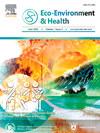Effects of 3D microstructure of porous media on DNAPL migration and remediation by surface active agents in groundwater
引用次数: 0
Abstract
Aquifers composed of porous granular media are important to human beings because they are capable of storing a large amount of groundwater. Contaminant migration and remediation in subsurface environments are strongly influenced by three-dimensional (3D) microstructures of porous media. In this study, fractal models are developed to investigate contaminant transport and surfactant-enhanced aquifer remediation (SEAR) for the regular tetrahedron microstructure (RTM) and right square pyramid microstructure (RSPM). The relationships of permeability and entry pressure are derived for these two kinds of 3D microstructures of granular porous media. Afterward, the difference in perchloroethylene (PCE) migration and SEAR efficiency between RTM and RSPM is investigated by the numerical simulation based on a synthetic heterogeneous granular aquifer. Results indicate that PCE penetrates faster and spreads farther in RSPM-based aquifers compared with RTM-based aquifers. Further, SEAR in RTM-based aquifers can achieve remediation efficiencies of 66.129%–92.214% with a mean of 84.324%, which is clearly lower than the SEAR efficiency of 70.149%–94.773% (with a mean of 89.122%) in RSPM-based aquifers. Findings are significant for understanding the 3D microstructure of porous media and how the microstructure of porous media affects macroscopic contaminant behaviors and remediation.

多孔介质的三维微观结构对地下水中 DNAPL 迁移和表面活性物质修复的影响
由多孔颗粒介质组成的含水层能够储存大量地下水,因此对人类非常重要。污染物在地下环境中的迁移和修复受到多孔介质三维(3D)微结构的强烈影响。本研究建立了分形模型,以研究正四面体微结构(RTM)和正方体金字塔微结构(RSPM)的污染物迁移和表面活性剂强化含水层修复(SEAR)问题。推导出了这两种三维颗粒多孔介质微结构的渗透率和进入压力关系。随后,通过基于合成异质颗粒含水层的数值模拟,研究了 RTM 和 RSPM 在全氯乙烯(PCE)迁移和 SEAR 效率方面的差异。结果表明,与基于 RTM 的含水层相比,基于 RSPM 的含水层中 PCE 的渗透速度更快,扩散距离更远。此外,在基于 RTM 的含水层中,SEAR 的修复效率为 66.129%-92.214%,平均值为 84.324%,明显低于基于 RSPM 的含水层中 SEAR 的 70.149%-94.773%(平均值为 89.122%)。研究结果对于了解多孔介质的三维微观结构以及多孔介质的微观结构如何影响污染物的宏观行为和修复具有重要意义。
本文章由计算机程序翻译,如有差异,请以英文原文为准。
求助全文
约1分钟内获得全文
求助全文
来源期刊

Eco-Environment & Health
环境科学与生态学-生态、环境与健康
CiteScore
11.00
自引率
0.00%
发文量
18
审稿时长
22 days
期刊介绍:
Eco-Environment & Health (EEH) is an international and multidisciplinary peer-reviewed journal designed for publications on the frontiers of the ecology, environment and health as well as their related disciplines. EEH focuses on the concept of “One Health” to promote green and sustainable development, dealing with the interactions among ecology, environment and health, and the underlying mechanisms and interventions. Our mission is to be one of the most important flagship journals in the field of environmental health.
Scopes
EEH covers a variety of research areas, including but not limited to ecology and biodiversity conservation, environmental behaviors and bioprocesses of emerging contaminants, human exposure and health effects, and evaluation, management and regulation of environmental risks. The key topics of EEH include:
1) Ecology and Biodiversity Conservation
Biodiversity
Ecological restoration
Ecological safety
Protected area
2) Environmental and Biological Fate of Emerging Contaminants
Environmental behaviors
Environmental processes
Environmental microbiology
3) Human Exposure and Health Effects
Environmental toxicology
Environmental epidemiology
Environmental health risk
Food safety
4) Evaluation, Management and Regulation of Environmental Risks
Chemical safety
Environmental policy
Health policy
Health economics
Environmental remediation
 求助内容:
求助内容: 应助结果提醒方式:
应助结果提醒方式:


